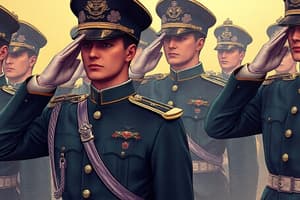Podcast
Questions and Answers
What do organizations rely on to monitor employees' performance?
What do organizations rely on to monitor employees' performance?
- Annual reports from subordinates (correct)
- Team-building activities
- Incentive programs
- Direct supervision only
How does effective organizational operation relate to employee behavior?
How does effective organizational operation relate to employee behavior?
- It requires employees to work irregular hours
- It relies on consistent coordination of activities (correct)
- It depends solely on financial rewards
- It focuses only on individual performance
What role do records and files play in an organization?
What role do records and files play in an organization?
- They serve no real function
- They provide a structured way to assess performances (correct)
- They are used solely for historical purposes
- They enable casual monitoring of employee activity
What consequence would a university face if it did not observe a lecture timetable?
What consequence would a university face if it did not observe a lecture timetable?
What does Foucault imply about timetables in organizations?
What does Foucault imply about timetables in organizations?
What aspect of employees' work is critical for effective operation in a business firm?
What aspect of employees' work is critical for effective operation in a business firm?
Why are activities scheduled according to precise timetables in organizations?
Why are activities scheduled according to precise timetables in organizations?
How do weak ties in networks serve individuals?
How do weak ties in networks serve individuals?
What percentage of remote workers currently work outside the office 80 percent or more of the time?
What percentage of remote workers currently work outside the office 80 percent or more of the time?
Which industry has the highest proportion of remote workers?
Which industry has the highest proportion of remote workers?
What was the estimated annual savings that Cisco achieved by allowing employees to telecommute?
What was the estimated annual savings that Cisco achieved by allowing employees to telecommute?
How much did Cisco estimate the reduction in carbon footprint due to telecommuting?
How much did Cisco estimate the reduction in carbon footprint due to telecommuting?
Why do employers view longer hours as a benefit of telecommuting?
Why do employers view longer hours as a benefit of telecommuting?
What is one major downside of telecommuting mentioned in the content?
What is one major downside of telecommuting mentioned in the content?
What age group is typically more prevalent among remote workers?
What age group is typically more prevalent among remote workers?
What substantial financial impact would occur if all workers compatible with home work could telecommute?
What substantial financial impact would occur if all workers compatible with home work could telecommute?
What is a significant change occurring in large organizations today regarding their structure?
What is a significant change occurring in large organizations today regarding their structure?
What term describes the detrimental effect of concentrated power in an organization, as articulated by Robert Michels?
What term describes the detrimental effect of concentrated power in an organization, as articulated by Robert Michels?
According to Burns and Stalker, what main drawback did they associate with traditional bureaucratic structures?
According to Burns and Stalker, what main drawback did they associate with traditional bureaucratic structures?
What has contributed to a shift away from strict hierarchical models in organizations?
What has contributed to a shift away from strict hierarchical models in organizations?
What has been the traditional view of how large organizations function according to Weber's model?
What has been the traditional view of how large organizations function according to Weber's model?
What challenge do large corporations face that limits original thinking?
What challenge do large corporations face that limits original thinking?
What is a characteristic of contemporary organizations in the electronic economy?
What is a characteristic of contemporary organizations in the electronic economy?
What happens to innovation as organizations become more bureaucratic according to past theories?
What happens to innovation as organizations become more bureaucratic according to past theories?
What concept did Robert Michels introduce to describe the flow of power in organizations?
What concept did Robert Michels introduce to describe the flow of power in organizations?
What aspect of bureaucracies concerned Weber the most?
What aspect of bureaucracies concerned Weber the most?
According to the content, in what scenario might power relationships become looser?
According to the content, in what scenario might power relationships become looser?
What does the term 'oligarchy' mean as referenced in the content?
What does the term 'oligarchy' mean as referenced in the content?
Michels claimed that unequal power distribution exists even in which type of organizations?
Michels claimed that unequal power distribution exists even in which type of organizations?
What is a potential drawback of bureaucratic power delegation mentioned in the content?
What is a potential drawback of bureaucratic power delegation mentioned in the content?
What was one of Weber's major concerns regarding modern organizations?
What was one of Weber's major concerns regarding modern organizations?
Why does the content suggest that the 'iron law of oligarchy' may not be universal?
Why does the content suggest that the 'iron law of oligarchy' may not be universal?
What is a primary characteristic of secondary groups compared to primary groups?
What is a primary characteristic of secondary groups compared to primary groups?
What concern did early sociologists like Cooley have regarding modern interactions?
What concern did early sociologists like Cooley have regarding modern interactions?
How does conformity to group pressure often manifest among teenagers?
How does conformity to group pressure often manifest among teenagers?
What did Solomon Asch's classic experiment primarily investigate?
What did Solomon Asch's classic experiment primarily investigate?
Which of the following is NOT a typical characteristic of secondary groups?
Which of the following is NOT a typical characteristic of secondary groups?
What role does conformity play in the behavior of males with respect to earring styles over time?
What role does conformity play in the behavior of males with respect to earring styles over time?
What conclusion can be drawn about the impact of group standards on individuals?
What conclusion can be drawn about the impact of group standards on individuals?
What kind of groups are more likely to concern themselves with strict group standards?
What kind of groups are more likely to concern themselves with strict group standards?
What term describes the tendency to judge oneself based on how one believes others perceive them?
What term describes the tendency to judge oneself based on how one believes others perceive them?
Which of the following best describes a reference group?
Which of the following best describes a reference group?
Which is an example of an out-group?
Which is an example of an out-group?
How might children benefit from exposure to positive reference groups?
How might children benefit from exposure to positive reference groups?
What is a primary reference group?
What is a primary reference group?
What does the term in-groups refer to?
What does the term in-groups refer to?
Which statement is true regarding secondary reference groups?
Which statement is true regarding secondary reference groups?
Which scenario demonstrates a person identifying with a reference group they do not belong to?
Which scenario demonstrates a person identifying with a reference group they do not belong to?
What does the 'McDonaldization' of society mean?
What does the 'McDonaldization' of society mean?
Which is NOT true about primary groups?
Which is NOT true about primary groups?
Which is NOT part of Weber's ideal type of bureaucracy?
Which is NOT part of Weber's ideal type of bureaucracy?
Flashcards
Reference group
Reference group
A group that provides a standard for judging one's own attitudes and behaviors.
In-groups
In-groups
Groups toward which one feels particular loyalty and respect.
Out-groups
Out-groups
Groups toward which one feels antagonism and contempt.
Dyad
Dyad
Signup and view all the flashcards
Looking-glass self
Looking-glass self
Signup and view all the flashcards
What is a reference group?
What is a reference group?
Signup and view all the flashcards
What are in-groups?
What are in-groups?
Signup and view all the flashcards
What are out-groups?
What are out-groups?
Signup and view all the flashcards
Primary Groups
Primary Groups
Signup and view all the flashcards
Secondary Groups
Secondary Groups
Signup and view all the flashcards
Social Conformity
Social Conformity
Signup and view all the flashcards
Asch Conformity Experiment
Asch Conformity Experiment
Signup and view all the flashcards
Groupthink
Groupthink
Signup and view all the flashcards
Social Pressure
Social Pressure
Signup and view all the flashcards
Need for Group Acceptance
Need for Group Acceptance
Signup and view all the flashcards
Social Conformity's Impact
Social Conformity's Impact
Signup and view all the flashcards
Performance Monitoring Systems
Performance Monitoring Systems
Signup and view all the flashcards
Timetables in Organizations
Timetables in Organizations
Signup and view all the flashcards
Surveillance in Organizations
Surveillance in Organizations
Signup and view all the flashcards
Direct Supervision
Direct Supervision
Signup and view all the flashcards
Files, Records, and Work Histories
Files, Records, and Work Histories
Signup and view all the flashcards
Regular Work Hours
Regular Work Hours
Signup and view all the flashcards
Spatial and Temporal Coordination
Spatial and Temporal Coordination
Signup and view all the flashcards
Physical Settings for Discipline
Physical Settings for Discipline
Signup and view all the flashcards
Iron Law of Oligarchy
Iron Law of Oligarchy
Signup and view all the flashcards
Oligarchy
Oligarchy
Signup and view all the flashcards
Less Hierarchical Organizations
Less Hierarchical Organizations
Signup and view all the flashcards
Weber's Model of Bureaucracy
Weber's Model of Bureaucracy
Signup and view all the flashcards
Bureaucracy Stifles Innovation
Bureaucracy Stifles Innovation
Signup and view all the flashcards
Horizontal Collaboration Models
Horizontal Collaboration Models
Signup and view all the flashcards
Outdated Bureaucratic Structures
Outdated Bureaucratic Structures
Signup and view all the flashcards
Burns and Stalker's Observation
Burns and Stalker's Observation
Signup and view all the flashcards
Loss of power in organizations
Loss of power in organizations
Signup and view all the flashcards
Flow of power towards the top
Flow of power towards the top
Signup and view all the flashcards
Bureaucracies
Bureaucracies
Signup and view all the flashcards
Unequal power in smaller organizations
Unequal power in smaller organizations
Signup and view all the flashcards
Looser power relationships in larger organizations
Looser power relationships in larger organizations
Signup and view all the flashcards
Delegation of power
Delegation of power
Signup and view all the flashcards
Power distribution in bureaucracy
Power distribution in bureaucracy
Signup and view all the flashcards
Telecommuting
Telecommuting
Signup and view all the flashcards
Carbon Footprint Reduction
Carbon Footprint Reduction
Signup and view all the flashcards
Commuting Time
Commuting Time
Signup and view all the flashcards
Work-Life Flexibility
Work-Life Flexibility
Signup and view all the flashcards
Job Satisfaction
Job Satisfaction
Signup and view all the flashcards
Productivity
Productivity
Signup and view all the flashcards
Benefits of Telecommuting
Benefits of Telecommuting
Signup and view all the flashcards
Drawbacks of Telecommuting
Drawbacks of Telecommuting
Signup and view all the flashcards
Study Notes
Military Discipline at West Point
- West Point Academy's military discipline relies heavily on fear of punishment from superiors, positive reinforcement from superiors, group loyalty and conformity to social norms, and personal motivation and self-discipline.
Studying That Suits You
Use AI to generate personalized quizzes and flashcards to suit your learning preferences.




